We’ve all heard time and time again how eating fruits and vegetables is healthy for us, and it definitely is. Hopefully, everybody here is getting their five-a-day. But that also raises an interesting question: which fruits do people prefer?
It’s practically impossible to track exactly how much of each type of fruit people consume worldwide, so we’ll use global production figures as a proxy. Presumably, farmers would be loathe to grow produce that nobody buys, so production figures should be a reliable indicator of consumption, as well.
Now, we all have our own preferences, and nowhere is that more true than when food is concerned. Don’t feel the need to change yours because of this list. But I always find it fascinating to see how individual choices compound on a global level. There are billions of people living on Earth today, and our food combined diets have, throughout history, shaped the world around us.
So let’s see what fruits we’re all munching on — statistically speaking.
Tomatoes
The least fruit-tasting fruit out there is, actually, the one that sees the highest production levels worldwide.
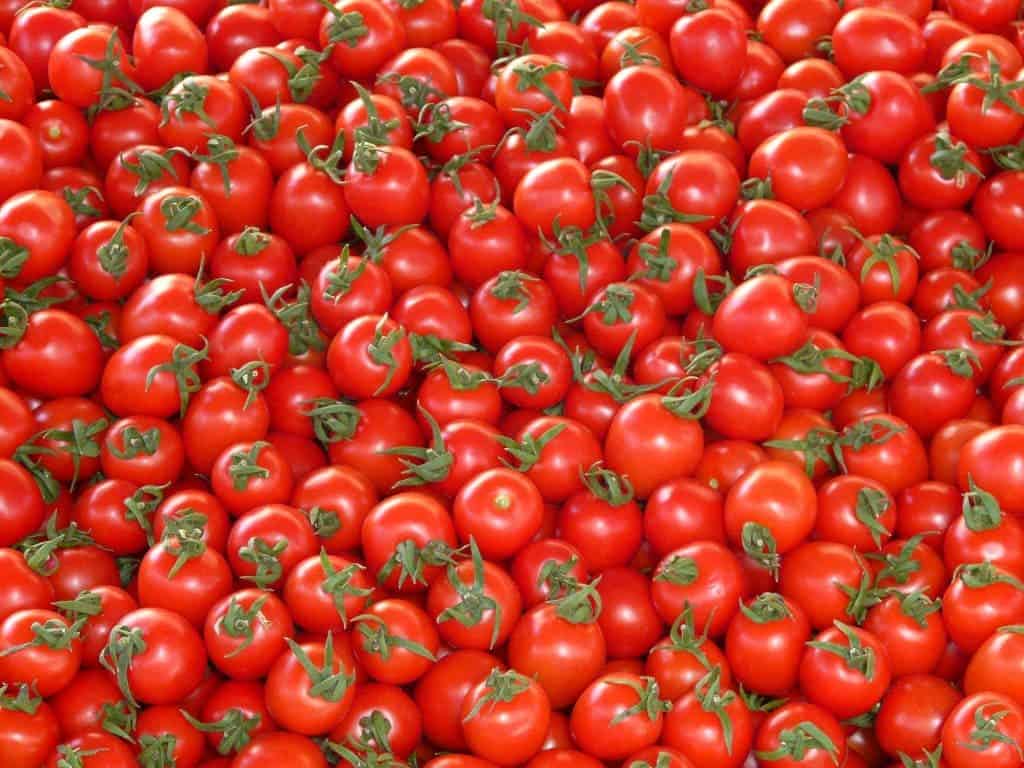
Tomatoes are a bit of an outlier on this list. Taxonomically speaking, they are fruits (berries, to be specific). But from a practical point of view, they’re employed as vegetables for salads, sauces, or cooked dishes.
The tomato originates from the American continents and was introduced to the rest of the world following the Columbian exchange, the single largest transfer of people, plants, and animals in history. Our earliest records suggest tomatoes were being cultivated by locals in the areas where they’re endemic (in the Andes, Peru, Chile, Ecuador, and the western stretches of Bolivia) since around 700 AD. Today, they’re virtually indispensable in multiple culinary traditions, including Mediterranean cooking.
Spanish and Portuguese explorers brought tomatoes back to Europe — and from there, the world — but what really made them a hit was that, at first, rich people died trying to eat them.
When it was first introduced to Europe tomatoes were, quite understandably, very expensive. Due to that, only well-off people could really afford to buy them — and they were probably also quite interested in doing so, both as a status symbol and due to sheer curiosity. Another thing rich people of the time used to show off their wealth and status were metal plates and cutlery, generally made out of pewter. And it was these plates that would make the tomato one of the most feared fruits in 1700’s Europe — when it was widely known as the ‘poison apple’.
You see, tomato juice is quite acidic. Pewter is an alloy that’s in large part comprised of lead, and this will leach out when exposed to a strong-enough acid. Eat enough lead and you get lead poisoning and die. People at the time didn’t understand this process, but they could observe that nobles would eat tomatoes and die sometime later. So people started to avoid eating them, which dramatically lowered their price.
This, turns out, was a huge boon for the tomato, because poor, hungry people aren’t picky. They also don’t own pewter plates, so they wouldn’t get any lead poisoning from eating them.
Another issue that plagued the tomato during its early days is that the plant and roots themselves are quite toxic, even if the fruits are not. Until people learned to avoid these parts, this toxicity further helped lower the price of tomatoes, making them a staple of the common people.
Tomatoes today are virtually everywhere, and very popular for their versatility. They’re a great source of umami flavor, and one of the few plants out there that contain it, which would further explain their popularity.
In 2019, the world produced 181 million tonnes of tomatoes, with China being the main producer.
Bananas
The first undeniable fruit on the list also harbors a few secrets.
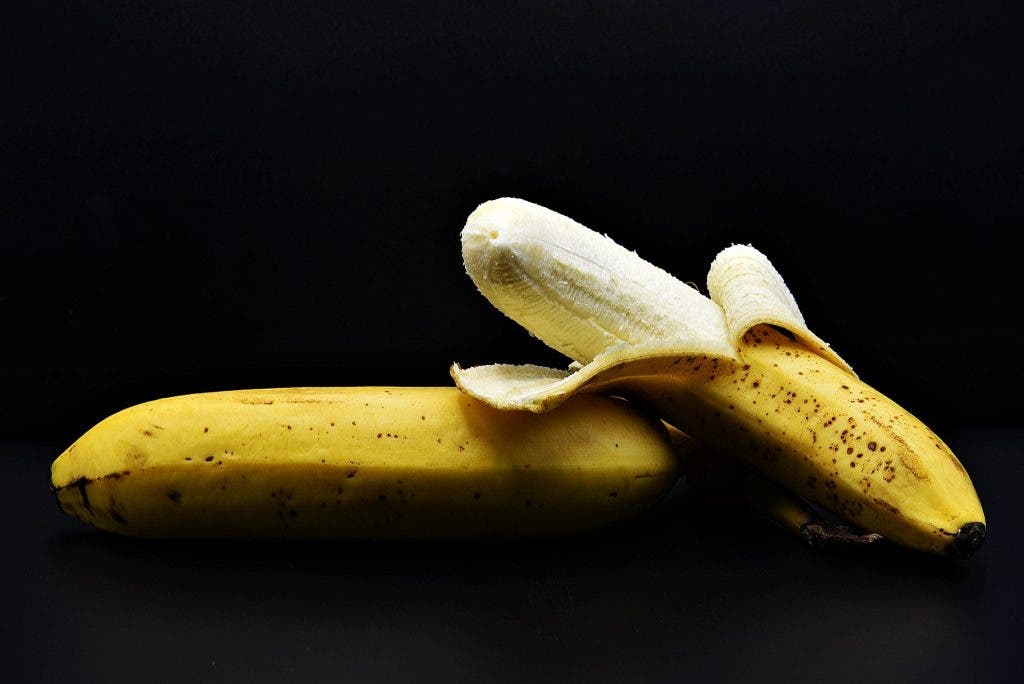
For starters, all the bananas you’ve ever eaten are, most likely, completely identical genetically. In essence, you’ve been eating the same banana over and over again. That’s because banana plants meant for commercial use are spread through saplings — they’re all clones.
They didn’t start out this way. The next time you bite into one, look for the very small seeds throughout the fruit’s pulpy core. Banana plants are spread through saplings because these seeds are very, very rarely viable. We’ve made them so. Wild bananas have large seeds in the middle of the fruit, to such an extent that eating one isn’t a pleasurable experience — it makes them borderline inedible, actually.
While the seeds of domesticated bananas are used for breeding programs, they have a low chance of germinating (growing into a plant). Furthermore, spreading the plants through samples of rhizome (a specialized type of root structure) allows farmers to reliably grow banana trees that have similar productivity, ensuring that their crops remain economically viable. This is made easier by the fact that bananas are parthenocarpic — they don’t need to be pollinated to bear fruit.
Naturally, there’s also downsides to this approach: for one, the root samples can carry diseases or pest from one plant to the new ones. Secondly, since all the plants in a crop are clones, a single pest or disease can wipe them all out. In theory, one could wipe out whole cultivars. It may sound like a pretty abstract issue, but it has actively lowered the quality of our bananas over time. Today, the Cavendish is the most common cultivar of banana. But up until the 1950’s, what you were most likely to find in a store were the Gros Michel variety. Taste-wise, these were reportedly much more enjoyable than the Cavendish. Artificial banana flavoring today tastes more like bananas than bananas themselves because they were based on the Gros Michel cultivar.
Sadly, the Panama disease virtually wiped out the Gros Michel — which, just like the Cavendish, were all clones of one another. The Cavendish cultivar was bred specifically to be more resistant to certain pests and diseases. That being said, in the wild or on small independent farms, bananas have much, much greater genetic diversity. Hopefully, this will act as an insurance policy, so we never have to give up bananas.
Another unusual aspect of the banana is how surprisingly radioactive it is. Large batches have been known, for example, to trigger sensors meant to identify smuggled nuclear material. This comes down to their high content of potassium (which is a good thing). One isotope of this element, potassium-40, is naturally radioactive. But worry not — unless you plan to eat a few million bananas in one sitting, you’re not getting radiation poisoning. And, honestly, if you reach that point, radiation won’t be your main issue.
Today, bananas are among the most cultivated plants out there, being the 4th biggest crop worldwide. In 2019, around 117 million metric tons of this yellow fruit were produced across the world, with India being the single largest grower.
Watermelons
Although their name implies the existence of earth-, fire-, and air- melons, so far we’ve only encountered watermelons.
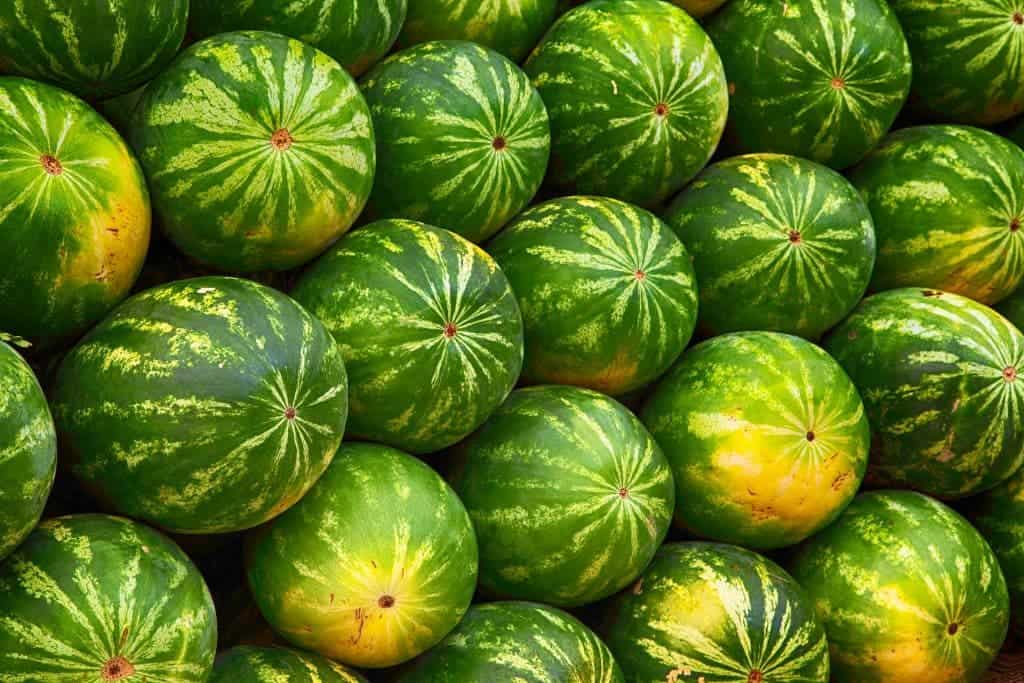
But boy oh boy are we happy we did. Watermelons are one of the most popular fruits on Earth, both in regards to quantity eaten, where it’s enjoyed, and how long it’s been enjoyed. Originally an African species, watermelons are part of the Cucurbitaceae family and closely related to the cucumber, squash, zucchini, and gourds. Biologically speaking it is, again, despite its looks, a berry.
Our earliest evidence of watermelon farming comes from around 4000 to 5000 years ago in ancient Egypt. Seeds of various cultivars have even been found buried with the Pharaos, which showcases just how popular and appreciated these fruits were even back then.
It quickly spread to any and all areas with a favorable climate. By the 7th century watermelons reached India, and by the 10th century, China. Between the 10th and 12th centuries it was also introduced to Europe, mainly by Muslim peoples from Northern Africa, and it became quite common here by the 17th century. From here, it made its way to the new world, and even Native Americans are documented to have grown watermelons in the Mississippi and Florida areas in the 17th century. Pacific island natives were also quite excited to adopt the crop as European explorers first encountered them.
Why would explorers have watermelons on them? Well, with a water content that can reach up to 92% by weight, they make excellent canteens, especially on long voyages where wooden barrels holding drinking water would routinely rot or become salty.
One especially interesting variety of watermelon is the seedless kind. While it’s tempting to assume that someone messed around with some watermelon DNA to produce them, that isn’t exactly the case. Seedless watermelons are actually produced by crossing a variety with 22 chromosomes with one that has 44 chromosomes. This results in an infertile, seedless hybrid, much like a mule.
But if you get the variety with seeds, you can practice your hand at breaking a world record. More specifically, the seed-spitting world record. You’re trying to beat Jason Schayot who, according to the Guinness Book of World Records, spit watermelon seeds a distance of 75 feet 2 inches (22.9108 meters) on August 12, 1995, at a seed-spitting festival in Georgetown, Texas. The seeds are actually edible, however, and quite nutritious, if you’d rather not spit.
In 2019, around 100.41 million metric tons of watermelon were grown worldwide, with China leading production.
Apples
The humble apple is iconic in European and Asian cultures and is one of the oldest domesticated fruits on the planet.
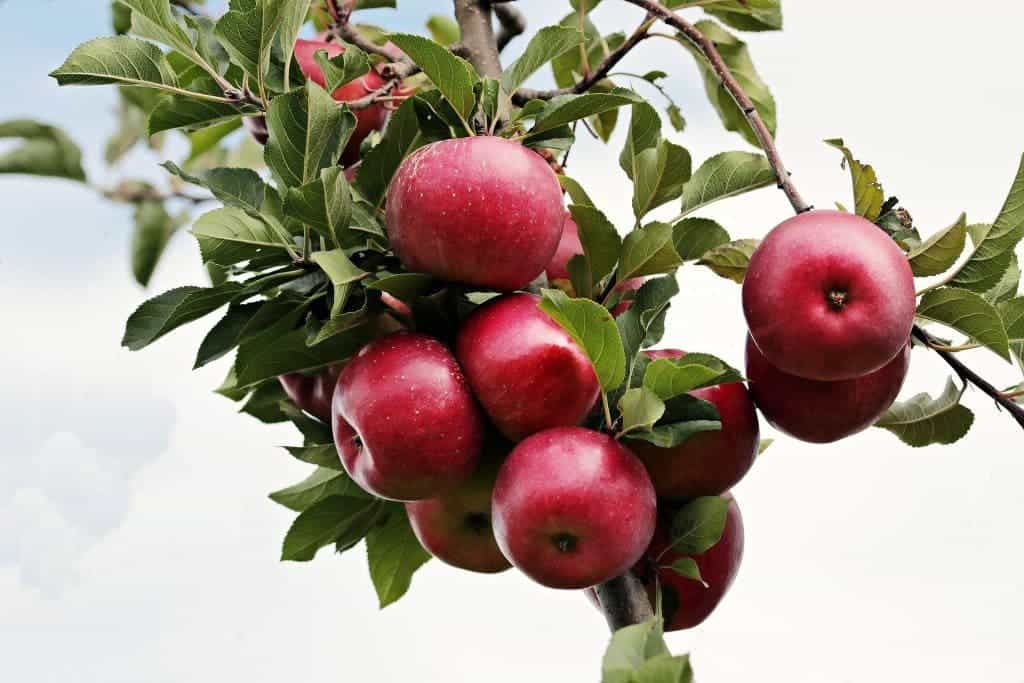
Since it’s been grown for so long and carried around by various groups of people, exactly where it originates is still a matter of some debate — but for now, the consensus is that the apple was born somewhere in central Asia. According to our best estimates, people found and first domesticated the apple around the Tian Shan mountain range between 4,000 and 10,000 years ago.
In those days, they most likely resembled crab apples in both appearance and taste. These are considerably smaller and less sweet than the apples you’re used to today, and can be quite sour and hard to bite into.
Apple trees today are mainly grown through grafting. Basically, this involves cutting the mid-upper parts of a growing tree, and attaching (grafting) an apple tree cutting on top. It’s quite like making a Frankenstein tree, and it’s not that hard to pull off if you know how to do it.
One interesting tidbit regarding the apple is that it often pops up in mythos as the ‘golden’ apple, usually for a hero to take back from some monster or another. Probably the earliest example of this (at least in Europe) is Greek mythology. But — and this is an important but — in Middle English, which was spoken as late as the 17th century, the word ‘apple’ was used to refer to any fruit (apart from berries), so ‘golden apples’ aren’t necessarily apples. That being said, other languages didn’t have this peculiarity, so the golden apples of Greek or Romanian mythos were, indeed, apples.
Everybody here knows what apples are. Sweet, crunchy, juicy. They keep doctors away. We won’t dwell too much on them. However, there is one last tidbit I’d like to discuss here. You might have heard that apple seeds are toxic — they are. Apple seeds contain amygdalin, which is broken down into hydrogen cyanide during digestion. Hydrogen cyanide is a decidedly deadly compound. But there’s no need to panic if you’ve bitten into a seed or six — an adult would need to ingest between 150 and a few thousand apple seeds (depending on how crushed or chewed they are) to have any issues. And, if you don’t chew them at all, they just pass harmlessly through you.
In 2019, global production of apples reached around 87.2 million metric tons, with China being the leading producer.
And now, in last place on this list, we have a bit of a tie!
Oranges and Grapes
Oranges — the common name for ‘sweet oranges’ — aren’t actually a naturally occurring fruit. They were developed by people, as a cross between the pomelo and the mandarin orange. Our earliest written evidence of the orange comes from around 300 BC, from Chinese literature.
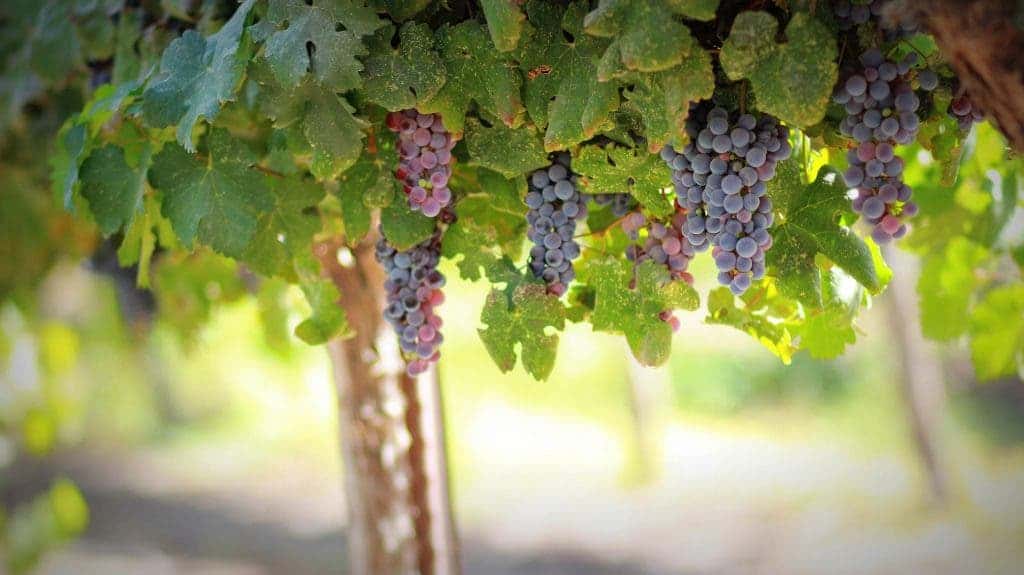
Interestingly, despite its artificial origin, the sweet orange is the most cultivated fruit tree in the world, and accounts for most of the citrus production worldwide.
On the other hand, we have grapes. These are wildly-occurring fruits (berries), unlike the sweet orange. Grapes are believed to have originated in the Middle East, and we estimate they’ve been cultivated for a very long time now: between 6,000 to 8,000 years.
Needless to say, you can’t make wine without grapes. But that’s true in more ways than one — yeast, probably the first domesticated microorganism, that’s been used since time immemorial to produce alcohol, lives on the skin of grapes. Perhaps unsurprisingly, then, our earliest evidence of wine-making hails from around 8,000 years ago in present-day Georgia (the one in Europe, not America). They didn’t waste any time getting brewing, did they?
You can’t talk about any of the ancient European civilizations, nor ancient Egypt, without mentioning grapes and wine. The Phoenicians, Greeks, Romans, and people of Cyprus grew grapes for consumption and wine-making. Ancient Egyptians also grew the purple variety. These are pigmented with anthocyans, a class of colored compounds that give red wines their incredible hues.
So, why are these fruits tied? Is it because they’re both tasty and a good base for drinks? No. Is it their bright colors? Their preference for warm climates? Not really. It’s just that, production-wise, they’re pretty much neck and neck.
In 2019, global production of oranges reached 78.7 million metric tons, while that of grapes was around 77.14 million metric tons. Brazil was the single largest producer of oranges that year, while China led the way on grapes.


